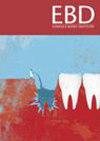Can monolithic zirconia frameworks in implant-supported cross-arch prostheses deliver reliable long-term outcomes?
IF 2.3
Q3 Dentistry
引用次数: 0
Abstract
A retrospective cohort study assessing the mid-to-long-term outcomes and risk factors affecting the prosthetic success and survival of implant-supported cross-arch fixed dental prostheses (IFCDPs) with monolithic zirconia frameworks. Forty-seven patients received a total of 51 cross-arch prostheses (27 maxillary and 24 mandibular prostheses), supported by 302 implants. Comprehensive clinical and radiographic records were available over a follow-up period ranging from 5 to 13 years. A strict inclusion criteria ensured the use of screw-retained implants and monolithic zirconia frameworks fabricated using standardised CAD/CAM protocols, without cemented titanium bases. Exclusion criteria included systemic conditions affecting healing, bruxism, uncontrolled periodontitis, smoking, and significant health changes during the follow-up period. Descriptive statistics summarised implant and prosthesis outcomes, while complications were evaluated for peri-implantitis at an implant level and framework fractures at a prosthesis level. Peri-implantitis was identified through clinical signs, including bleeding on probing, suppuration, and radiographic evidence of bone loss. Prosthetic outcomes were classified using the modified USPHS criteria. Mixed-effects Cox regression models were applied to analyse risk factors. Hazard ratios were calculated for peri-implantitis and framework fractures, with statistical significance set at p < 0.05. The implant survival rate was 97.64%, with peri-implantitis observed in 27 implants, predominantly in the mandible, resulting in an overall implant success rate of 91.06%. Prosthesis survival was 82.35%, with nine framework fractures reported, eight of which occurred in mandibular prostheses. The mandible was identified as a significant risk factor for both framework fractures (HR = 11.64, p = 0.024) and peri-implantitis (HR = 10.88, p = 0.003). IFCDPs with monolithic zirconia-based frameworks exhibited favourable clinical outcomes over a 5–13-year period. However, mandibular prostheses were more prone to framework fractures and peri-implantitis, highlighting the need to consider mandibular flexure in prosthetic design to enhance long-term success and durability.单片氧化锆框架在种植体支持的交叉弓假体中能否提供可靠的长期效果?
设计:一项回顾性队列研究,评估影响整体氧化锆框架种植体支持的十字弓固定义齿(ifcdp)修复成功和存活的中长期结果和危险因素。队列选择:47例患者共接受51个交叉弓假体(27个上颌假体和24个下颌假体),由302个种植体支撑。在5至13年的随访期间,可获得全面的临床和放射学记录。严格的纳入标准确保使用螺钉保留的植入物和使用标准化CAD/CAM协议制造的整体氧化锆框架,而不需要粘合钛基。排除标准包括影响愈合的全身性疾病、磨牙、不受控制的牙周炎、吸烟和随访期间的重大健康变化。数据分析:描述性统计总结了种植体和假体的结果,同时评估了种植体水平的种植体周围炎和假体水平的框架骨折的并发症。通过临床症状,包括探探出血、化脓和骨质流失的影像学证据来确定种植体周围炎。使用修改后的USPHS标准对假体结果进行分类。采用混合效应Cox回归模型分析危险因素。结果:种植体成活率为97.64%,种植体周围炎27例,以下颌骨为主,整体种植成功率为91.06%。假体存活率为82.35%,报告9例框架骨折,其中8例发生在下颌假体。下颌骨被认为是框架骨折(HR = 11.64, p = 0.024)和种植体周围炎(HR = 10.88, p = 0.003)的重要危险因素。结论:整体氧化锆框架ifcdp在5-13年期间表现出良好的临床结果。然而,下颌假体更容易发生框架骨折和种植体周围炎,这突出了在假体设计中考虑下颌屈曲以提高长期成功和耐用性的必要性。
本文章由计算机程序翻译,如有差异,请以英文原文为准。
求助全文
约1分钟内获得全文
求助全文
来源期刊

Evidence-based dentistry
Dentistry-Dentistry (all)
CiteScore
2.50
自引率
0.00%
发文量
77
期刊介绍:
Evidence-Based Dentistry delivers the best available evidence on the latest developments in oral health. We evaluate the evidence and provide guidance concerning the value of the author''s conclusions. We keep dentistry up to date with new approaches, exploring a wide range of the latest developments through an accessible expert commentary. Original papers and relevant publications are condensed into digestible summaries, drawing attention to the current methods and findings. We are a central resource for the most cutting edge and relevant issues concerning the evidence-based approach in dentistry today. Evidence-Based Dentistry is published by Springer Nature on behalf of the British Dental Association.
 求助内容:
求助内容: 应助结果提醒方式:
应助结果提醒方式:


